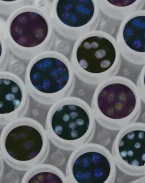Brain's Frontier Exploration

Neuroscience as a frontier of human knowledge
Neuroscience, the study of the nervous system and the brain, is a rapidly evolving field that has the potential to transform humans as a species. The past 60 years have seen incredible breakthroughs in the understanding of how brain cells contribute to our thoughts, senses, and movements.
One of the most exciting recent developments in neuroscience has been the ability to interface brains with machines. A paralyzed woman was able to control a robotic arm with her brain, and a company called Neuralink has developed a chip capable of recording thousands of neurons at once.
However, despite these breakthroughs, the complexity of the human brain and nervous system remains a major challenge. With 86 billion neurons and 100 trillion synapses packed into a small space, the human brain is a circuit of mind-boggling complexity.
This complexity has made it difficult for neuroscientists to understand and study the brain. Even the simple nervous system of a tiny worm with only 302 neurons is a challenge to understand. The brain’s soft, tofu-like consistency makes it difficult to record multiple cells simultaneously, especially those in the middle of the brain.
Despite these challenges, the potential for neuroscience to transform human understanding of ourselves and the world around us is enormous. The quest to understand the brain and nervous system is a frontier of human knowledge that holds the promise of unlocking new understanding of who we are and what we are capable of.
Challenges in studying and understanding the brain
Studying and understanding the brain is one of the most daunting challenges faced by scientists today. Despite the significant breakthroughs in neuroscience, there are still many unknowns and difficulties in understanding the brain.
One of the major challenges in studying the brain is the difficulty in dissecting the connectome, the wiring diagram of the brain. The connectome contains the complex and dense network of neurons and synapses that make up the nervous system. While there is a rough draft of the connectome, it is already incredibly complicated, and dissection at the synapse level is estimated to take millions of years.
Additionally, there is a debate over the usefulness of the connectome. Some neuroscientists believe that it is not a useful tool for understanding how the brain works. While it provides information on the gross connection patterns between major brain regions, there is no clear relationship between the structure of the neuronal circuit and behavior.
However, there is still hope in unlocking the secrets of the brain. Scientists have been using new technologies to simulate, stimulate, and record from the brain, such as using laser beams to activate new types of neurons and using novel machine learning algorithms to derive insights from complex neural data. There is also a need for new theories of the brain that are experimentally falsifiable.
The challenges in studying the brain are immense, but the potential rewards for understanding the brain are equally enormous. By understanding the brain, we can unlock new understanding of ourselves and the world around us.
Synaptic plasticity and memory
The brain’s ability to learn and acquire memories is a hallmark of any nervous system. Synaptic plasticity, the ability of synapses to change in strength and connectivity, is key to this process.
However, there are difficulties in understanding how memory is encoded in a neural network. For even a simple impression to be remembered, the strings of many different synapses must be tuned intelligently. Learning requires retuning the network of neurons, but this kind of rebirth must allow pre-birth memory to be encoded in the network. How the nervous system does this is still unknown.
The brain is constantly bombarded with all kinds of inputs at unpredictable times, and those inputs must be paired with other outputs. This creates a problem for the nervous system, as too much plasticity would compromise previous memories and compromise the stability of the system. It is a delicate balance between learning and stability.
Understanding how memory is encoded in the brain is essential for understanding consciousness, the awareness of ourselves as beings capable of moving, thinking, and sensing with subjective experience. While most neuroscientists believe that consciousness arises from the material brain, there is still an unbridgeable gap between neuronal firings and our actual experiences.
Finding the minimal neuronal mechanisms sufficient for any cognitive abilities remains the holy grail for many neuroscientists. But with new technologies and theories, there is hope for unlocking the secrets of the brain and understanding consciousness. By continuing to study synaptic plasticity and memory, we can unlock new understanding of ourselves and the world around us.
Known unknowns in neuroscience: the relationship between neuronal circuits and behaviors, the nature of memory, and the neuronal correlates of consciousness
Neuroscience is a frontier of human knowledge that has made significant strides in understanding the nervous system, including the brain, over the past 60 years. However, there are still many unknowns in the field, including the relationship between neuronal circuits and behaviors, the nature of memory, and the neuronal correlates of consciousness.
One of the major challenges in studying the brain is the difficulty in dissecting and understanding the connectome, or the complete synapse-level wiring diagram of the brain. Even if neuroscientists could speed up the process of dissection, it would still take thousands of years to decode the connectome of just one human brain.
There is also a debate over the usefulness of the connectome in understanding how the brain works. Some neuroscientists believe that the connectome is fundamentally not useful for understanding the brain and that it may be just irrelevant details.
Another challenge in neuroscience is understanding how the brain encodes memory in a neural network. While synaptic plasticity, or the modifiability of synaptic connection strength, is key to learning and memory, it is difficult to understand the relationship between memory and which synapses to tune and by how much their connection strengths must be tuned.
Despite these challenges, new technologies and approaches are being developed to push the frontiers of knowledge in neuroscience. These include using laser beams to activate new types of neurons, using carbon nanotube electrodes to record from the brain, and using novel machine learning algorithms to understand and derive insights from complex neural data.
However, to truly understand the brain and consciousness, a new paradigm of thought may be necessary. The current understanding of the brain may not be sufficient, and a new way of thinking about the brain may be required to truly unlock its mysteries.
In conclusion, while there are many known unknowns in neuroscience, the field continues to push the frontiers of knowledge with new technologies and approaches. It is only through continued research and exploration that we may one day unlock the mysteries of the brain and consciousness.
Conclusion
Neuroscience is an exciting and rapidly evolving field that holds great potential for transforming human life. However, studying and understanding the brain remains one of the greatest challenges of modern science. The complexity of the human brain and nervous system presents many obstacles to unlocking its secrets, including the difficulties in dissecting the connectome and encoding memory in a neural network. Furthermore, there is still much that is unknown about the relationship between neuronal circuits and behaviors, the nature of memory, and the neuronal correlates of consciousness.
Despite these challenges, neuroscientists continue to push the frontiers of knowledge in the field. New technologies and approaches, such as laser beams, carbon nanotube electrodes, and machine learning algorithms, are helping to advance our understanding of the brain. However, there is still a need for a new paradigm of thought to fully comprehend the workings of the brain and the nature of consciousness.
Ultimately, the goal of neuroscience is to not only understand the brain but to also find effective treatments for debilitating brain diseases and to unlock the secrets of consciousness. It is an exciting time for neuroscience, and as new discoveries continue to be made, we can only hope that a rebirth of our understanding of the brain is on the horizon.














